Illinois, a state rich in diverse wildlife, is home to an array of caterpillars, some of which are beautiful, while others are potentially harmful. With their intricate patterns and varied colors, caterpillars intrigue nature enthusiasts, gardeners, and kids alike. However, it’s important to note that amongst these fascinating creatures, a few of these species bear toxins that can pose a risk upon contact. In this article, we will explore various caterpillars found in Illinois, and we’ll make sure to spotlight some that are poisonous as well, to help you safely navigate and appreciate the world of these remarkable creatures.
1. Army Cutworm Caterpillar (Euxoa auxiliaris)

Army cutworm caterpillars eat various crops, including alfalfa and field corn.
©Frank Peairs, Colorado State University, United States / CC BY 3.0 US – License
Mature army cutworm caterpillars reach lengths of 1.5 to 2 inches. Their color ranges from gray to black, with the back being darker than the belly. The head is typically brown and marked with darker spots. These army cutworm caterpillars can be found munching on crops like alfalfa, barley, canola, and field corn, as well as garden plants, various grasses, and weeds. If you come across one of these caterpillars, don’t worry; they are harmless.
The adult form of the army cutworm caterpillar is referred to as a miller moth.
2. Fall Webworm Caterpillar (Hyphantria cunea)
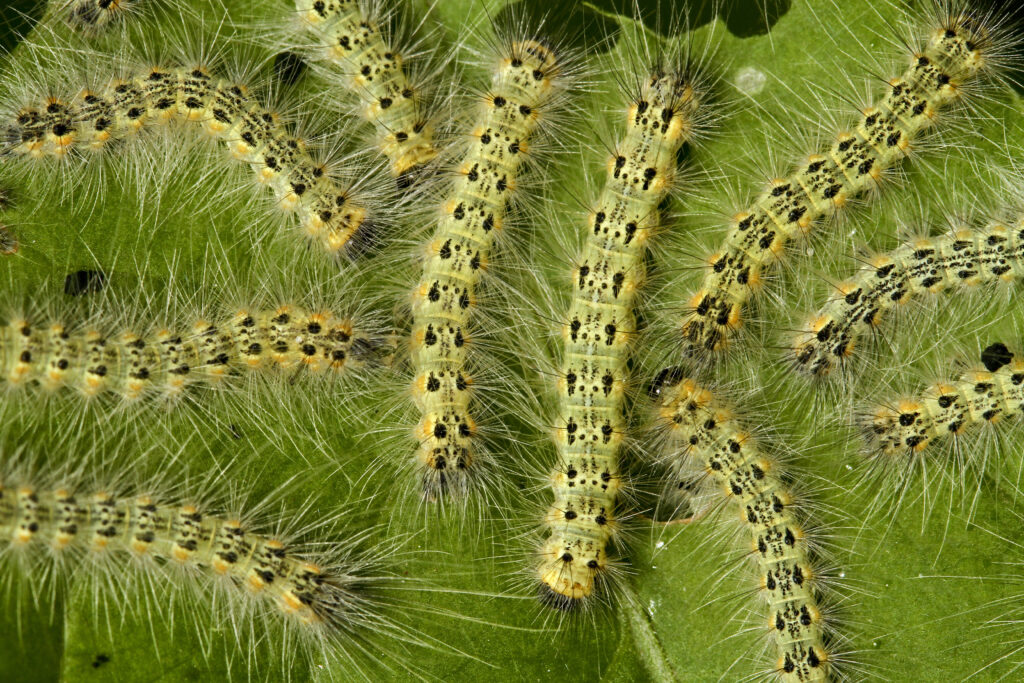
Fall webworm caterpillars can range in color from yellowish-green to dark gray.
©Geza Farkas/Shutterstock.com
These caterpillars are often easier to recognize in their larval form than as adult moths! The color of fall webworms can vary widely, from a light yellowish-green to a dark gray shade, and they have thin pale hairs. These caterpillars have a diverse diet, feeding on over 100 different types of woody broadleaf plants, such as poplar, sycamore, and willow trees.
Despite their appearance, webworms are harmless. They don’t bite or carry any toxins, and they’re generally viewed as a bothersome pest rather than a serious threat.
3. Eastern Tent Caterpillar (Melacosoma americanum)
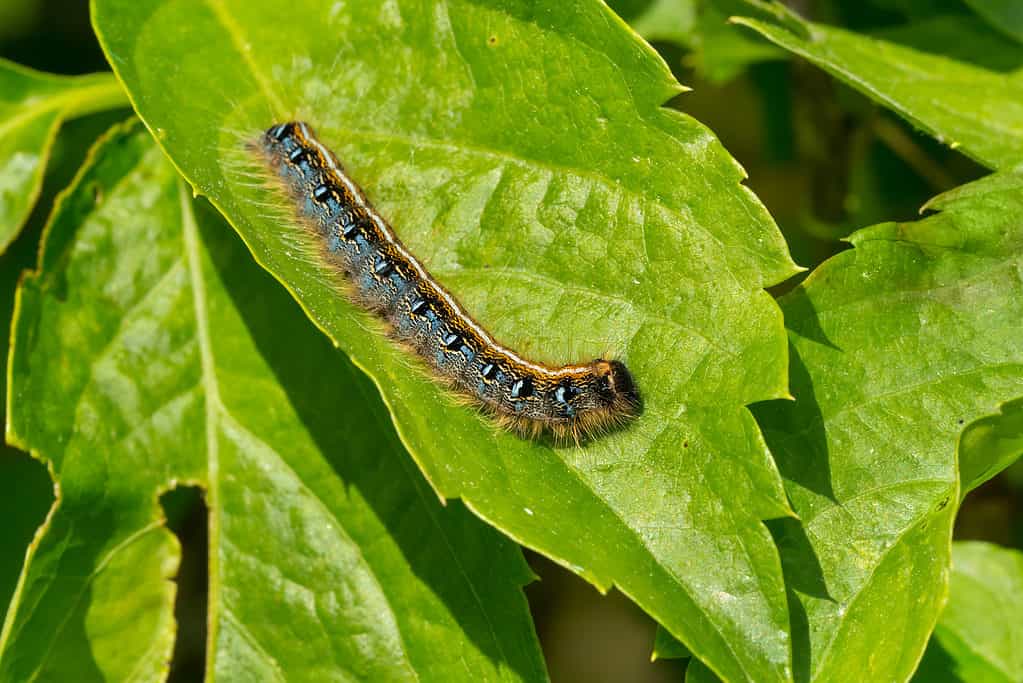
Eastern tent caterpillars are covered in hair and have a distinctive blue, black, and orange patterning.
©Paul Reeves Photography/Shutterstock.com
Identifying eastern tent caterpillars is relatively easy. The larvae are covered in hair and bear blue, black, and orange patterns with a distinctive line running down their backs. Although mostly smooth, they have a row of hairs protruding from the sides of their bodies and reach a length of two inches when fully matured. These caterpillars have a particular preference for feasting on wild cherry, apple, and crabapple trees.
Unlike some other caterpillars, eastern tent caterpillars are not a danger to humans or animals. They eventually transform into moths, a stage of life that lasts only around five days before they perish.
4. Io Moth Caterpillar (Automeris io)

Io moth caterpillars start off reddish-brown but turn into a bright green color as it matures.
©Andy Reago & Chrissy McClarren / CC BY 2.0 – License
The young Io moth caterpillar is reddish-brown in color, marked by six light-colored stripes and six rows of spine-bearing bumps. As it goes through stages of its growth, the caterpillar turns into a bright green color, and the longitudinal stripes appear clearer and lighter in color. This caterpillar is known for its diverse diet, feeding on various plants such as grasses, herbaceous flora, shrubs, deciduous trees, and even conifers.
A word of caution: the Io moth caterpillar is notorious for its stinging capabilities. Among the list of stinging caterpillars, it ranks quite high. The spines covering its body are linked to poison glands, making it a particularly troublesome insect.
5. Evergreen Bagworm Caterpillar (Thyridopteryx ephemeraeformis)

At first glance, the evergreen bagworm moth may look like a moving pine cone.
©Young Swee Ming/Shutterstock.com
The caterpillar of the evergreen bagworm moth often baffles those who encounter it, resembling a moving pine cone to the naked eye. These caterpillars create a unique silk cocoon, adorning it with pieces of dead plant material. They have a broad diet, feeding on the leaves and tender stems of various trees and shrubs, including the evergreen variety.
Though not toxic, this bagworm is known as a significant pest due to the damage it can cause to plants.
6. Buck Moth Caterpillar (Hemileuca maia)

Buck moth caterpillars are brown to purplish black in color.
©iStock.com/Oleg Marchak
A full-grown buck moth caterpillar measures 2 to 2.5 inches in length, has a color ranging from brown to purplish black, and is speckled with numerous yellow spots. Its body is adorned with branching black spines, sometimes with red or black tips. You can frequently find them on oak or willow trees in Illinois, especially from spring to mid-summer. The diet of buck moth caterpillars consists mainly of oak trees.
This caterpillar possesses stinging spines linked to venom glands!
7. Saddleback Caterpillar (Acharia stimulea)
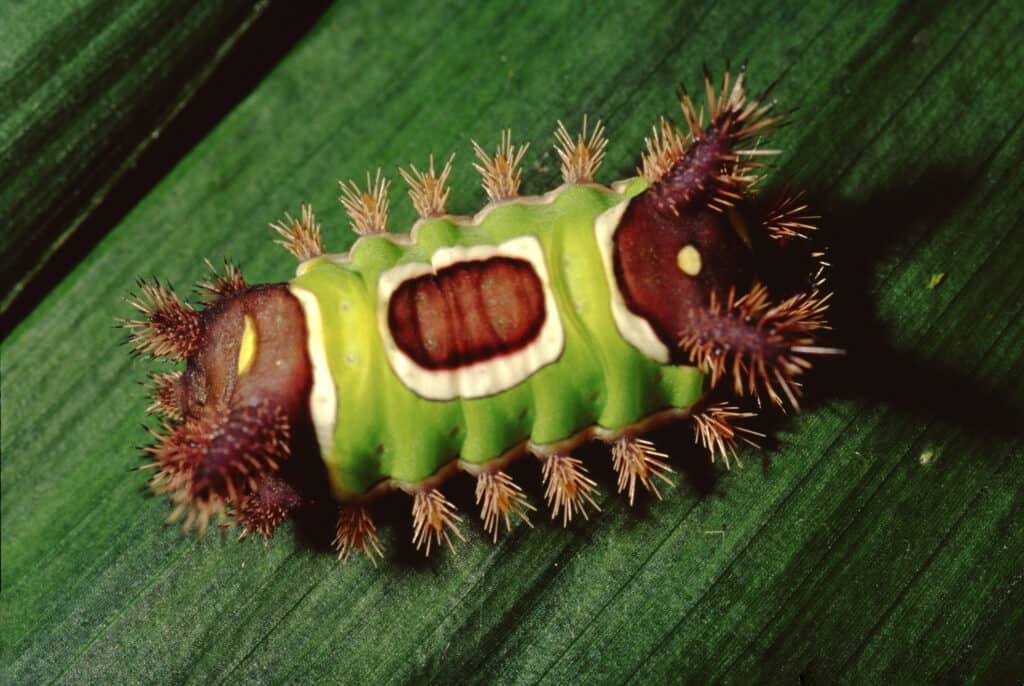
One of the most interesting caterpillars in Illinois is the saddleback caterpillar.
©Liz Weber/Shutterstock.com
Saddleback caterpillars stand out with their green backs, highlighted by a central brown dot encircled by white. Brown at both ends, their skin appears granulated, and they have pairs of fleshy, horn-like protrusions. In its larval stage, this caterpillar is about an inch long and has a body resembling a slug. These caterpillars are not picky eaters, feasting on the leaves of various plants, from gladiolas and crape myrtle to many more.
It’s important to note that this particular caterpillar is one of the toxic varieties found in Illinois, so caution is advised. The pain and swelling that occurs is often compared to a bee sting.
8. Garden Tiger Moth Caterpillar (Arctia caja)
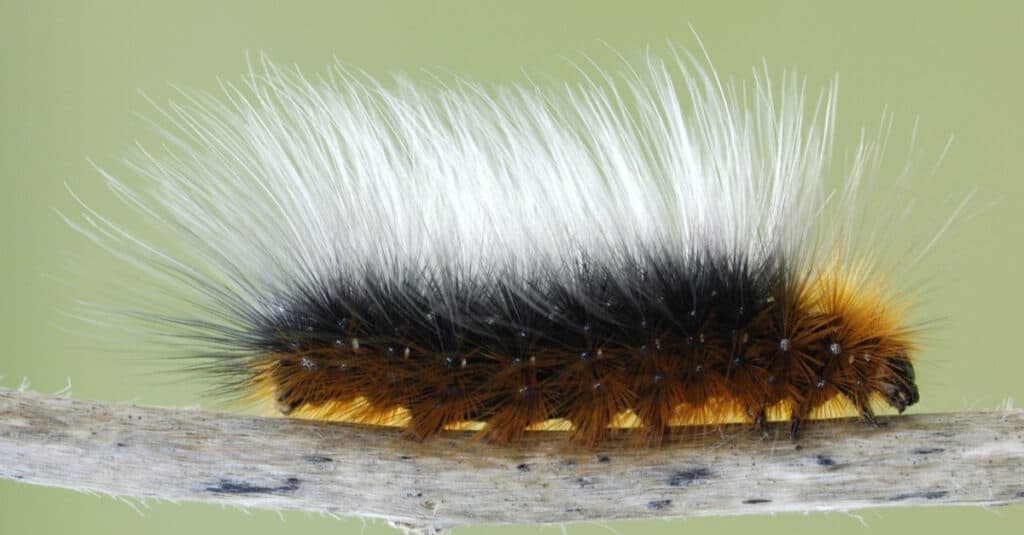
A beautiful specimen, the garden
tiger
caterpillar haws long and dense hairs.
©Hugh Lansdown/Shutterstock.com
The garden tiger caterpillar is quite eye-catching, as it is large and black with an abundant covering of long, dense black and ginger hairs. These caterpillars enjoy a varied diet, munching on stinging nettles, dock leaves, and a wide array of garden plants.
Although they may look intriguing and furry, avoid touching tiger moth caterpillars with your bare hands. The thick, bristly hair that covers them can be harmful to humans, as it contains toxins.
9. Puss Caterpillar (Megalopyge opercularis)

A venomous species, the puss caterpillar is very furry.
©Chase D’animulls/Shutterstock.com
The puss caterpillar grows to around an inch in length and has a furry appearance. Its body is covered in thick hairs that range in color from tan to grayish-white, narrowing towards the rear. These caterpillars primarily feed on leaves, favoring trees like poplar, sallow, and willow, as they are herbivores.
The puss caterpillar carries venomous barbs in its hairy body, and a sting from this insect can cause intense pain, resulting in blisters that may persist for weeks. Eventually, the puss caterpillar transforms into the southern flannel moth.
10. Monarch Caterpillar (Danaus plexippus)

The monarch caterpillar eats only milkweed.
©Cathy Keifer/Shutterstock.com
One of the most recognizable caterpillars is the monarch, thanks to their characteristic yellow, black, and white stripes. They possess antennae-like tentacles at both ends of their body and can grow up to two inches long. Their diet is exclusive to milkweed!
Although beautiful, these insects are toxic and can be hazardous due to the specific diet they maintain during their larval stage. These fascinating caterpillars eventually become the widely admired monarch butterflies!
11. Pipevine Swallowtail Caterpillar (Battus philenor)

A purple-black caterpillar with orange spots, the pipevine swallowtail caterpillar is poisonous.
©Sundry Photography/Shutterstock.com
The pipevine swallowtail caterpillar is distinctively purple with orange spots, and its body features long, thread-like protrusions. Not only does it look unusual, but it’s also unpleasant to taste and toxic to birds and other creatures. Its diet is very specific, consisting only of the leaves from plants like birthworts and Dutchman’s pipes.
Both in its caterpillar form and as an adult butterfly, this species is poisonous, making it one of the unique and toxic insects found in Illinois.
12. White-Marked Tussock Moth Caterpillar (Orgyia leucostigma)
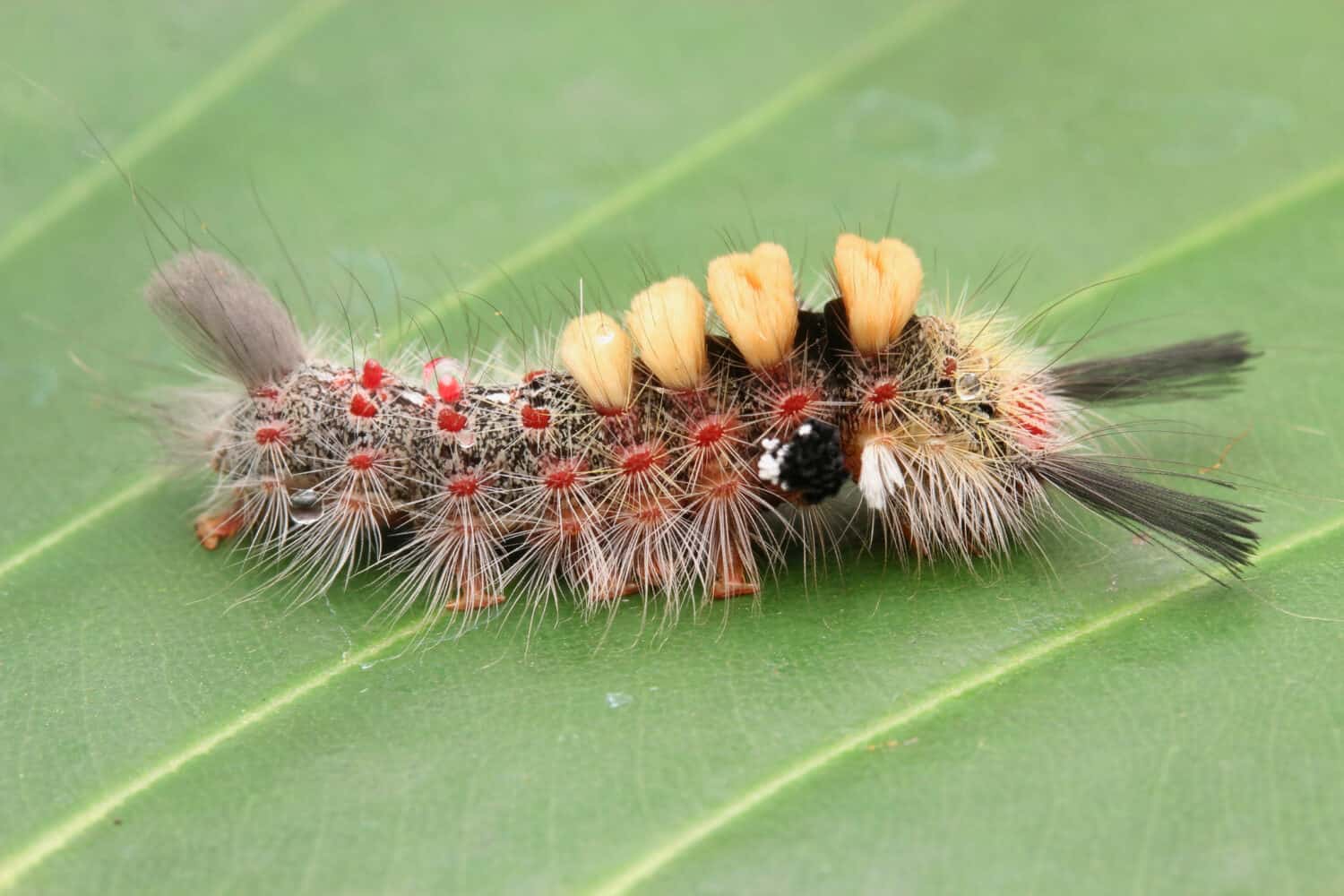
A unique-looking caterpillar, the white-marked tussock moth caterpillar has stripes and tufts.
©Zety Akhzar/Shutterstock.com
The white-marked tussock moth caterpillar is identifiable by its varying stripes and tufts, which can be either white or yellow. Unique features include four white or yellow tufts near the front, a bright red head, two small red dots towards the back, and a black stripe running down the center of their back, flanked by a yellow stripe below. This caterpillar’s diet consists of leaves from specific trees and plants like oaks, dogwoods, and blueberries.
While these caterpillars may cause skin rashes if touched, it’s worth noting that they are not considered poisonous.
13. Red Admiral Caterpillar (Vanessa atalanta)
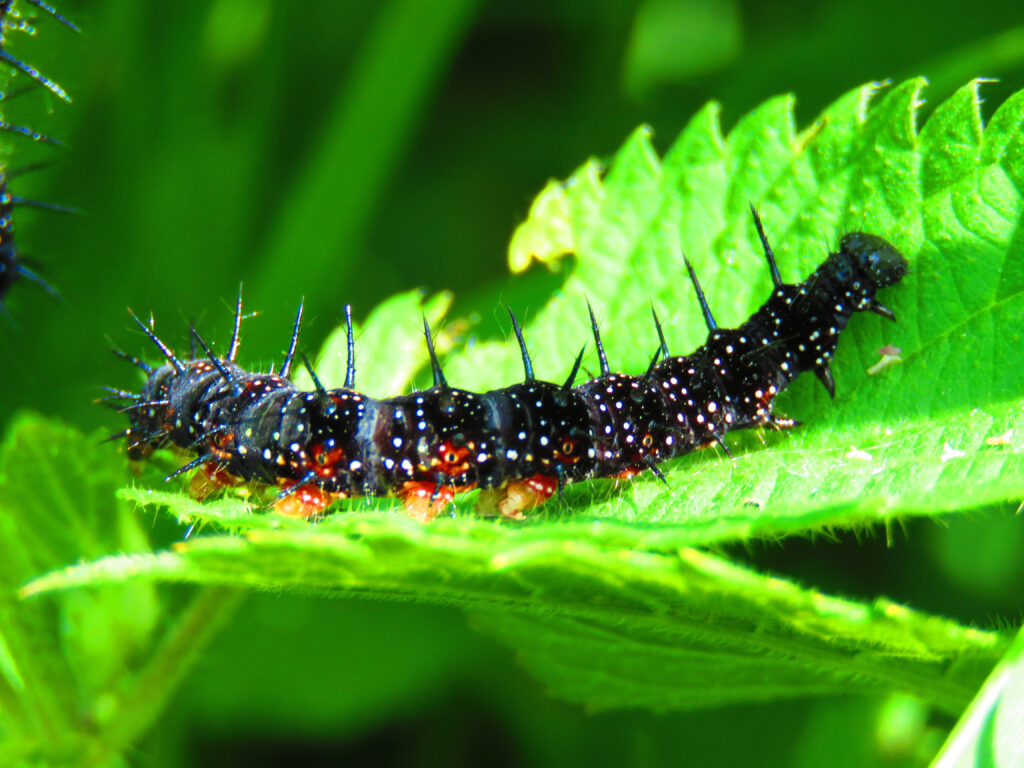
Although red admiral caterpillars may look toxic, they are safe to handle.
©Przemyslaw Muszynski/Shutterstock.com
Red admiral caterpillars undergo several changes during their larval stage, appearing in various colors like black or brown, with or without speckles. They are marked by many small bumps and dark, spiky protrusions. Their diet primarily consists of stinging nettles.
Despite their appearance, which may seem as though they could be harmful or toxic, red admiral caterpillars are completely safe to handle.
14. Question Mark Caterpillar (Polygonia interrogationis)

Growing to be around one and a half inches long, question mark caterpillars are covered in spines.
©Dank Pics/Shutterstock.com
Question mark butterfly caterpillars begin life as tiny insects but eventually grow to about one and a half inches in length. Their appearance includes a reddish-brown head adorned with short spines, along with a dark body that features pale, irregular lines and speckles. These caterpillars enjoy a diet that consists of stinging nettles, sugarberries, and various other plants.
Covered in yellow, orange, or black spines, they are well-protected from predators, but it’s worth noting that these spines are not venomous or harmful to humans.
15. Eastern Comma Caterpillar (Polygonia comma)
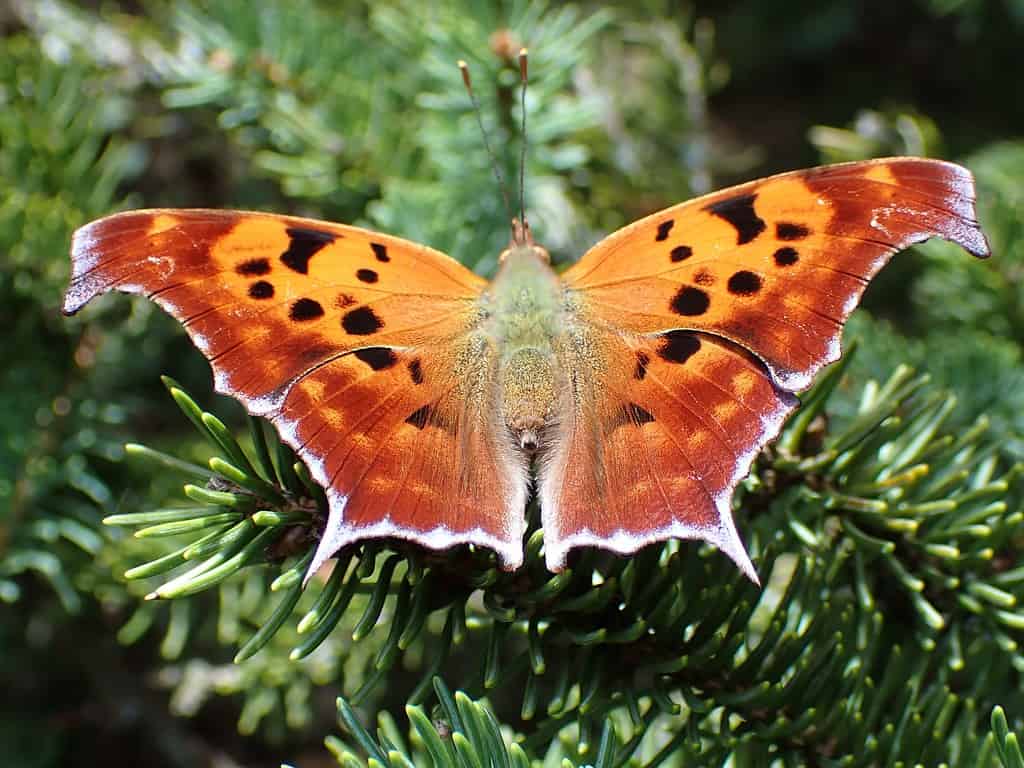
These caterpillars turn into eastern comma butterflies.
©Special Beauty/Shutterstock.com
Eastern comma caterpillars are generally brown and black in color, adorned with a prominent white mark near the tail end of their back. They also feature numerous branched spines that cover their bodies. Their diet consists of several plants, including paper birch, false nettle, hackberry, hops, and wood nettle.
These caterpillars aren’t toxic and generally don’t pose a risk to human health. However, it’s worth noting that they can cause damage to hop plants.
16. American Dagger Caterpillar (Acronicta americana)
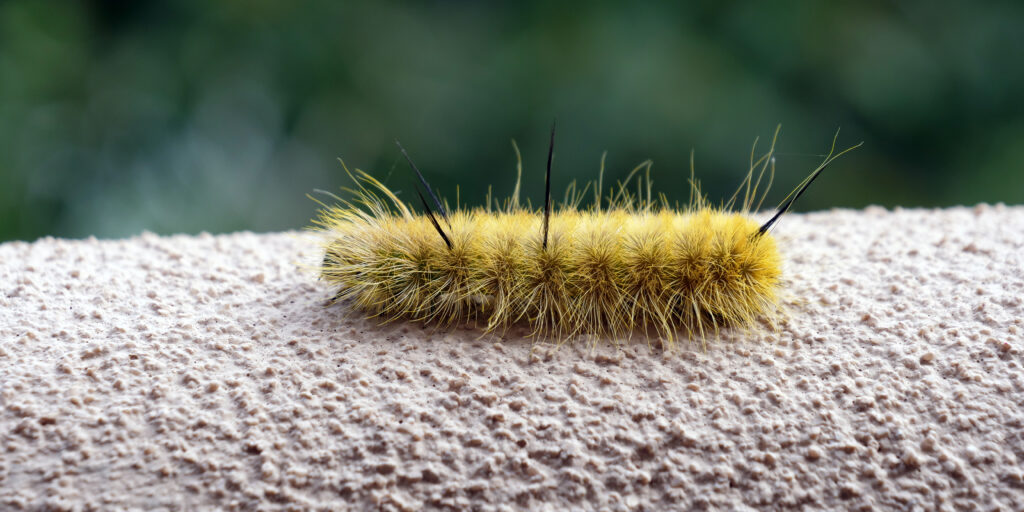
As you might be able to guess from their fuzzy appearance, American dagger moth caterpillars are harmful.
©Martha Marks/Shutterstock.com
American dagger moth caterpillars are recognizable by their fuzzy appearance, showcasing medium-length setae in shades of yellow, yellow-green, or white. Additionally, they have four slender, elegant black bristles extending from the first and third abdominal segments and a fifth near the rear end. They feed on the leaves of various hardwood trees, such as oak and willow.
These caterpillars can be harmful to both humans and pets. The risk is particularly high for children, who might unknowingly handle them while playing outdoors.
17. American Snout Caterpillar (Libytheana carinenta)
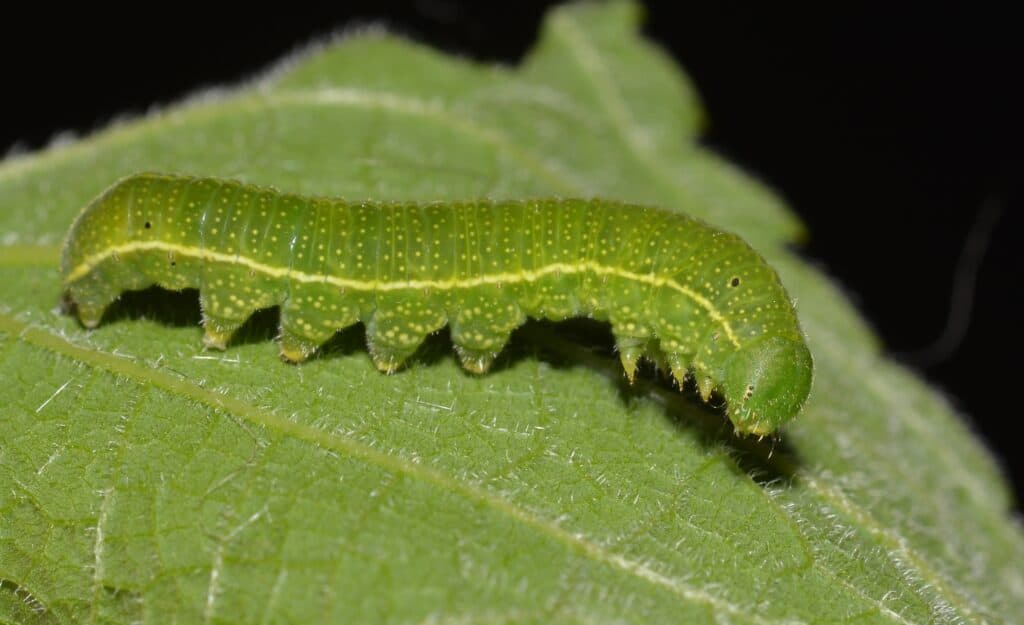
Not a poisonous species, American snout caterpillars are green in color.
©Andy Reago & Chrissy McClarren / CC BY 2.0 – License
American snout caterpillars have a green body adorned with yellow stripes along their back and sides, dotted with tiny yellow specks. As they mature, they become dark green, and the thorax region becomes enlarged, featuring two distinct black raised bumps. Their diet primarily consists of various hackberries, including the common hackberry, dwarf hackberry, and sugarberry.
Thankfully, these caterpillars are not harmful or poisonous to humans.
18. Cloudless Sulphur Caterpillar (Phoebis sennae)
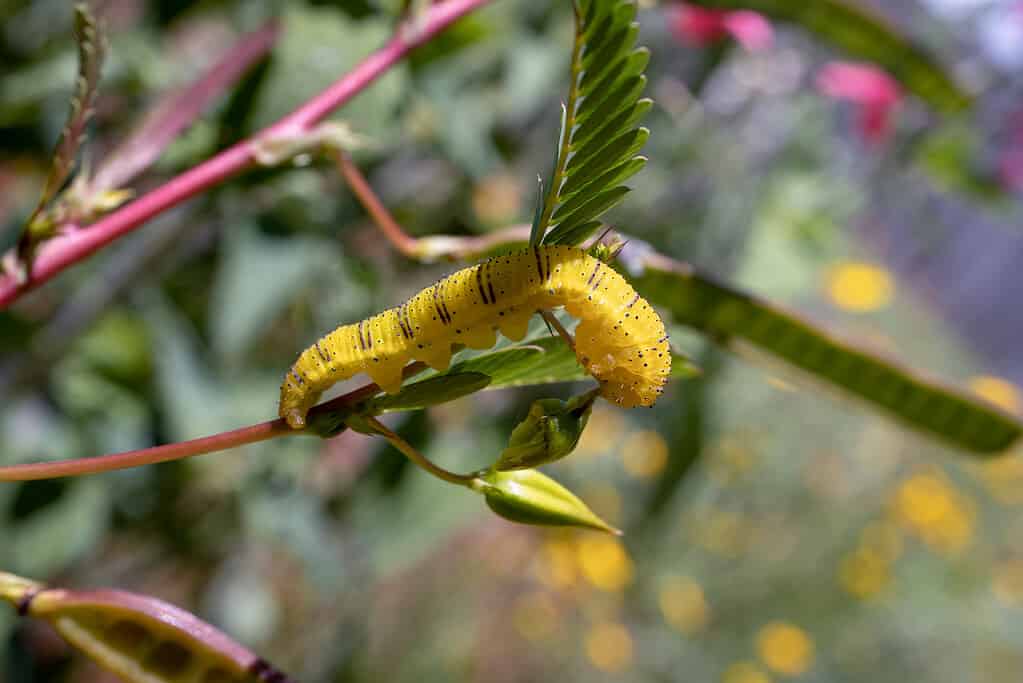
These caterpillars love plants of the
Sennaand
Cassiagenus.
©DrWD40/ via Getty Images
Cloudless sulphur caterpillars are distinguished by their yellow-to-green color. These caterpillars munch on leaves and flowers before transforming into adult butterflies. They primarily favor plants of the Senna and Cassia genera.
Interestingly, the caterpillars gain a toxic defense mechanism from their diet, as both Senna and Cassia plants are poisonous. This acquired toxicity helps deter predators, offering the caterpillar some protection in its vulnerable stage.
19. Luna Moth Caterpillar (Actias luna)

Another caterpillar you’ll find in Illinois is the luna moth caterpillar.
©iStock.com/ErikaMitchell
Luna moth caterpillars are identifiable by their light green color, marked with yellow lines on the sides and small red spots. The diet of luna moth caterpillars consists of the leaves of plants such as sweet gum and sumacs, among others.
Luna moth caterpillars are neither poisonous nor capable of stinging. They are entirely harmless creatures.
20. Common Buckeye Caterpillar (Junonia coenia)
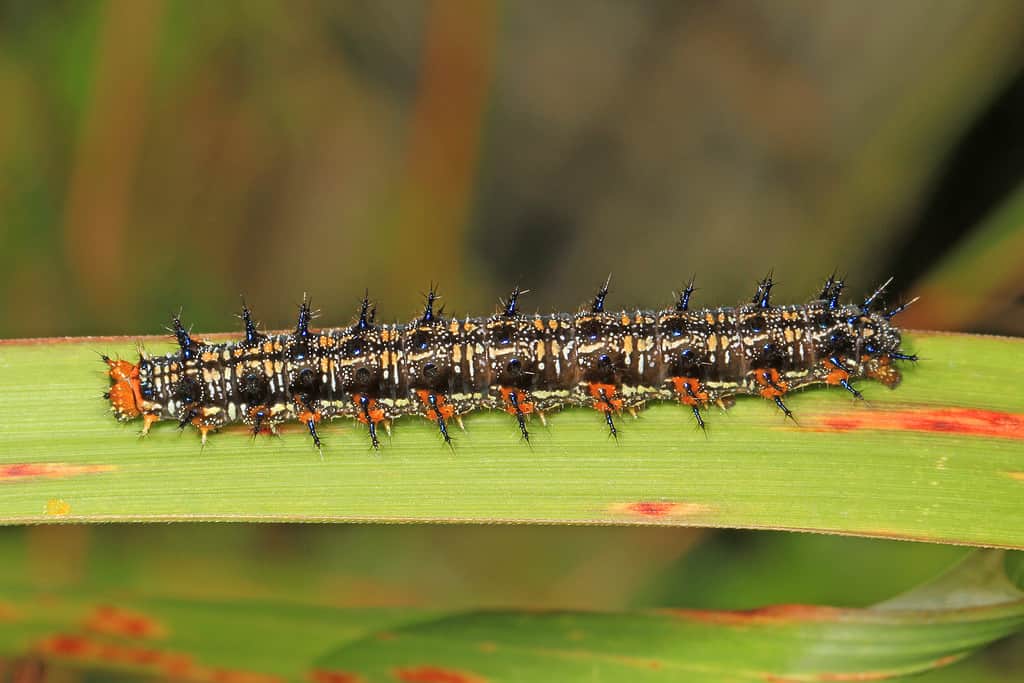
Adorned with stripes, spots, and spines, the common buckeye caterpillar is surprisingly harmless.
©Judy Gallagher / CC BY 2.0 – License
Common buckeye caterpillars are bluish-black in color and adorned with stripes and spots ranging from yellow to creamy orange. They also have metallic bluish-black spines that are short and branching. These spines emerge from prominent orange spots, and the head is notably black with an orange crown. These caterpillars tend to be solitary and primarily consume the leaves of the weed plantain and Gerardia, a plant known for its attractive flowers.
Although they are equipped with spines, buckeye butterfly caterpillars pose no harm.
Regions in Illinois With the Most Caterpillars
Each of the following regions in Illinois boasts a high caterpillar population due to factors such as diverse plant life, suitable habitats, and conservation efforts that protect native flora and fauna.
- Southern Illinois: The Shawnee National Forest in this region is brimming with diverse caterpillar species due to its abundant woodland areas and varied plant life, which caterpillars depend on for food and habitat.
- Sand Ridge State Forest: As the largest forest in Illinois, Sand Ridge State Forest is naturally home to a wealth of caterpillar diversity. The vast expanse of different trees and other vegetation types provides a perfect environment for various caterpillars.
- Central Illinois Prairies: Even though it’s primarily grassland, Central Illinois is home to several caterpillar species. The wildflowers and native plants in this area attract many types of butterflies and moths, leading to a diverse caterpillar population.
- Illinois River Valley: This area, with its rich biodiversity, is a haven for many caterpillar species. The combination of water proximity and diverse vegetation along the riverbanks provide ideal conditions.
- Chicago Area: Surprisingly, urban regions like Chicago also support a variety of caterpillars. City parks and gardens, particularly those with native plants, offer a habitat for these creatures.
- Illinois Forest Preserves: Preserves such as the Volo Bog State Natural Area or McHenry County Conservation District in Northern Illinois provide natural environments that support many caterpillar species.
Summary of Caterpillars Found in Illinois
| Caterpillar | Type of Caterpillar | Poisonous/Venomous? |
|---|---|---|
| Army Cutworm Caterpillar | Moth | No |
| Fall Webworm Caterpillar | Moth | No |
| Eastern Tent Caterpillar | Moth | No |
| Io Moth Caterpillar | Moth | Yes |
| Evergreen Bagworm Caterpillar | Moth | No |
| Buck Moth Caterpillar | Moth | Yes |
| Saddleback Caterpillar | Moth | Yes |
| Garden Tiger Moth Caterpillar | Moth | Yes |
| Puss Caterpillar | Moth | Yes |
| Monarch Caterpillar | Butterfly | Yes |
| Pipevine Swallowtail Caterpillar | Butterfly | Yes |
| White-marked Tussock Moth Caterpillar | Moth | No |
| Red Admiral Caterpillar | Butterfly | No |
| Question Mark Caterpillar | Butterfly | No |
| Eastern Comma Caterpillar | Butterfly | No |
| American Dagger Caterpillar | Moth | Yes |
| American Snout Caterpillar | Butterfly | No |
| Cloudless Sulphur Caterpillar | Butterfly | Yes |
| Luna Moth Caterpillar | Moth | No |
| Common Buckeye Caterpillar | Butterfly | No |
The photo featured at the top of this post is © Zety Akhzar/Shutterstock.com
Thank you for reading! Have some feedback for us? Contact the AZ Animals editorial team.







